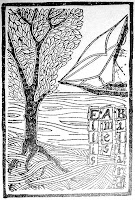A first thought might be that paper bookplates have declined with the rise of electronic books. But the strong sales through Amazon show that physical books made of paper remain popular. (Did book-owners place bookplates in their books more often when, unlike today, a plethora of books could not be so quickly and easily purchased -- thus perhaps making them seem more precious?)
What interests me more about bookplates, however, particularly those from half-a-century to a century ago, are the designs of the artwork that adorn them. Especially the way Nature so lovingly appears in the bookplates dating from about 1900 to 1950.
I know about them from owning two books published by Dover containing hundreds of samples from that pre-World War II era. There are bookplate illustrations with the lacy filigree of Art Nouveau, and bookplate illustrations with the streamlined polish of Art Deco.
Whatever the style or era, what I notice is the ways Nature appears in the art. In a fair number of instances, the artwork portrays a person reading outdoors. (Do people read outdoors much anymore?) Even if the artwork portrays an inviting reading nook in the corner of a house, there will be a window there with a garden view for the imaginary reader to delight in when they look up from their book.
 My hunch is that there is an unconscious symbolic connection between books and Nature. When we read, and thus connect our minds and hearts with another living person, something living within us grows -- just like those living plants so frequently drawn by Art Nouveau bookplate artists. Oliver Wendell Holmes, Sr. spoke to this enlivening quality of reading by making a comparison to the stimulating effect of music. He wrote:
My hunch is that there is an unconscious symbolic connection between books and Nature. When we read, and thus connect our minds and hearts with another living person, something living within us grows -- just like those living plants so frequently drawn by Art Nouveau bookplate artists. Oliver Wendell Holmes, Sr. spoke to this enlivening quality of reading by making a comparison to the stimulating effect of music. He wrote:
"The best of a book is not the thought which it contains, but the thought which it suggests; just as the charm of music dwells not in the tones but in the echoes of our hearts."
~~~
If you had only three books to keep forever (and adorn with bookplates), what would those three books be?

1 comment:
I would keep books that I can read again and again that nourish my spirits. My choices would be the Tao Te Ching, a history of art book, and a book of poems (I'm undecided about which one.)
Post a Comment